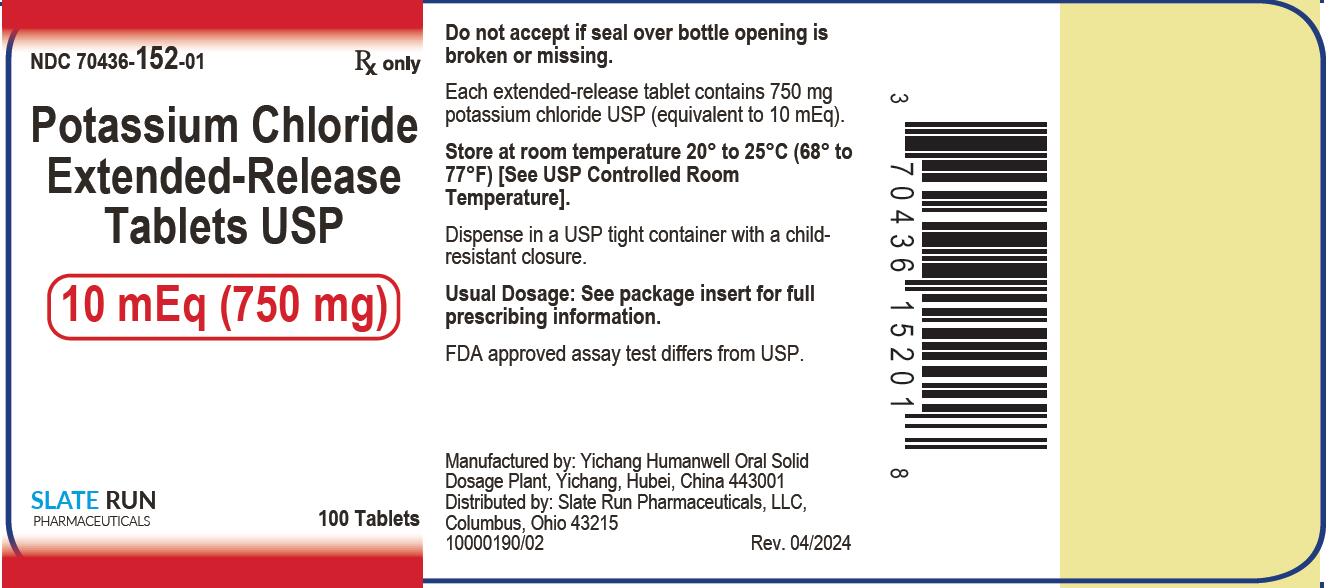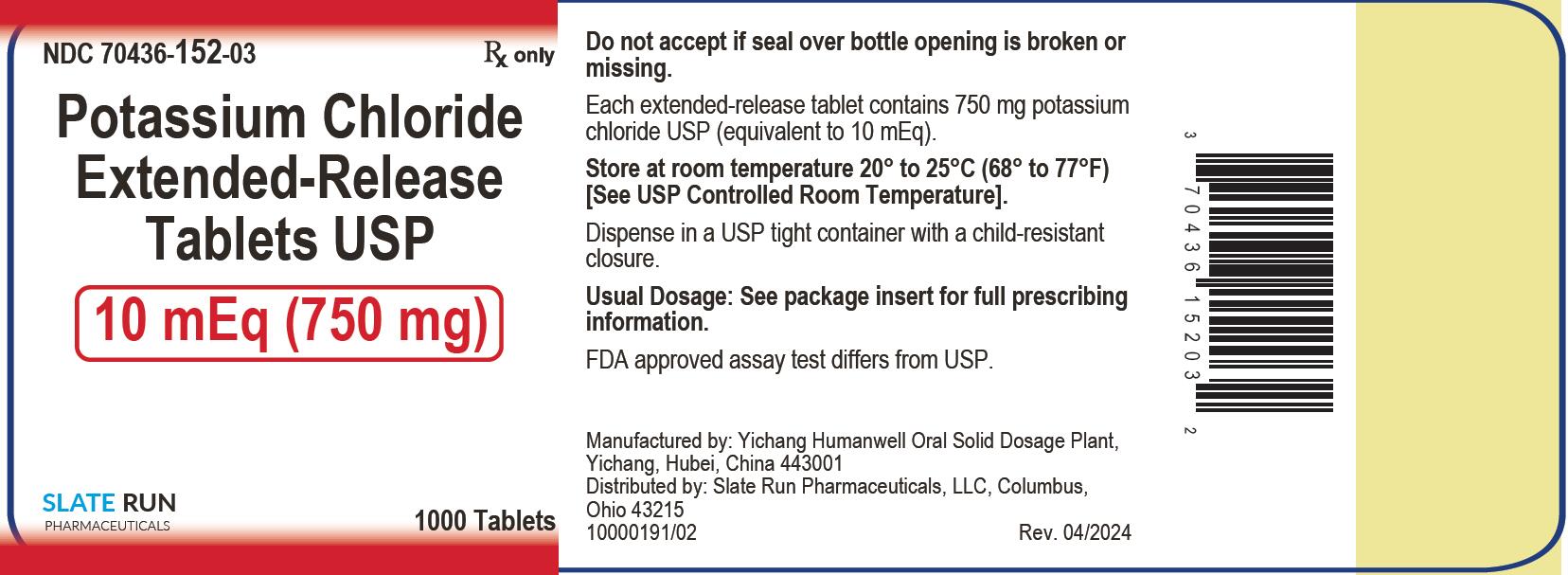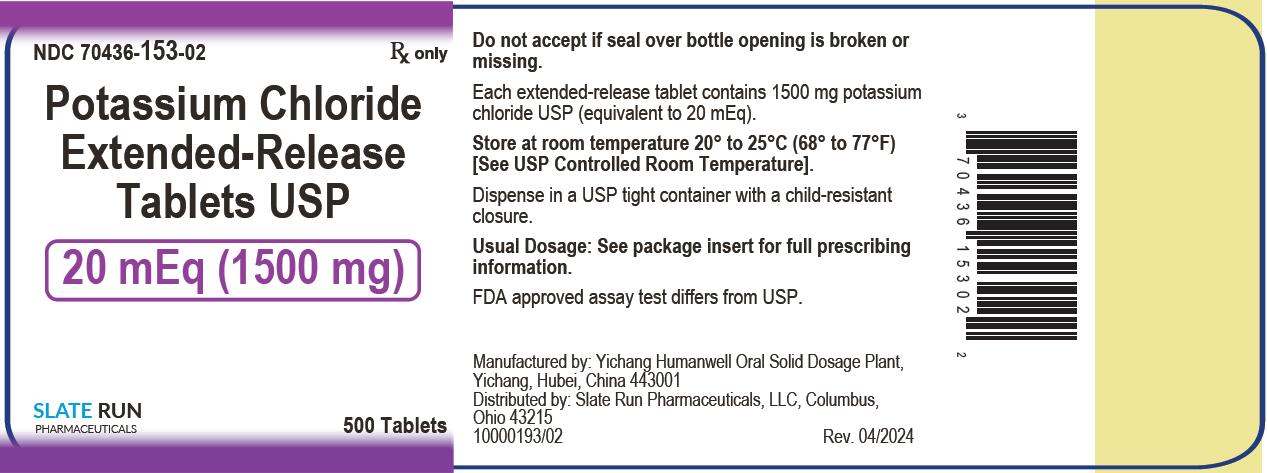Label: POTASSIUM CHLORIDE tablet, film coated, extended release
- NDC Code(s): 70436-152-01, 70436-152-03, 70436-153-01, 70436-153-02
- Packager: Slate Run Pharmaceuticals, LLC
- Category: HUMAN PRESCRIPTION DRUG LABEL
Drug Label Information
Updated December 7, 2023
If you are a healthcare professional or from the pharmaceutical industry please visit this version.
- Download DRUG LABEL INFO: PDF XML
- Official Label (Printer Friendly)
-
HIGHLIGHTS OF PRESCRIBING INFORMATION
These highlights do not include all the information needed to use POTASSIUM CHLORIDE EXTENDED-RELEASE TABLETS safely and effectively. See full prescribing information for POTASSIUM CHLORIDE EXTENDED-RELEASE TABLETS.
POTASSIUM CHLORIDE extended-release tablets, for oral use
Initial U.S. Approval: 1948INDICATIONS AND USAGE
Potassium Chloride Extended-Release Tablets are a potassium salt indicated for the treatment and prophylaxis of hypokalemia with or without metabolic alkalosis in patients for whom dietary management with potassium-rich foods or diuretic dose reduction is insufficient. (1)
DOSAGE AND ADMINISTRATION
• Monitor serum potassium and adjust dosages accordingly (2.1)
• If serum potassium concentration is less than 2.5 mEq/L, use intravenous potassium instead of oral supplementation (2.1)
• Take with meals and with a glass of water or other liquid. Swallow tablets whole. (2.1)
• Treatment of hypokalemia: Typical dose range is 40 to 100 mEq per day in divided doses. Limit doses to 20 mEq per dose. (2.2)
• Prevention of hypokalemia: Typical dose is 20 mEq per day (2.2)WARNINGS AND PRECAUTIONS
• Gastrointestinal Adverse Reactions: Can produce ulcerative and/or stenotic lesions of the gastrointestinal tract, particularly when in prolonged contact with the gastrointestinal mucosa. Take with meals. (5.1)
ADVERSE REACTIONS
Most common adverse reactions are nausea, vomiting, flatulence, abdominal pain/discomfort, and diarrhea (6)
To report SUSPECTED ADVERSE REACTIONS, contact Slate Run Pharmaceuticals, LLC at 1-888-341-9214 or FDA at 1-800-FDA-1088 or www.fda.gov/medwatch.
DRUG INTERACTIONS
USE IN SPECIFIC POPULATIONS
See 17 for PATIENT COUNSELING INFORMATION.
Revised: 11/2021
-
Table of Contents
FULL PRESCRIBING INFORMATION: CONTENTS*
1 INDICATIONS AND USAGE
2 DOSAGE AND ADMINISTRATION
2.1 Monitoring and Administration
2.2 Dosing
3 DOSAGE FORMS AND STRENGTHS
4 CONTRAINDICATIONS
5 WARNINGS AND PRECAUTIONS
5.1 Gastrointestinal Adverse Reactions
6 ADVERSE REACTIONS
7 DRUG INTERACTIONS
7.1 Triamterene and Amiloride
7.2 Renin-Angiotensin-Aldosterone System Inhibitors
7.3 Nonsteroidal Anti-Inflammatory Drugs
8 USE IN SPECIFIC POPULATIONS
8.1 Pregnancy
8.2 Lactation
8.4 Pediatric Use
8.5 Geriatric Use
8.6 Cirrhotics
8.7 Renal Impairment
10 OVERDOSAGE
10.1 Symptoms
10.2 Treatment
11 DESCRIPTION
12 CLINICAL PHARMACOLOGY
12.1 Mechanism of Action
12.2 Pharmacokinetics
13 NONCLINICAL TOXICOLOGY
13.1 Carcinogenesis, Mutagenesis, Impairment of Fertility
16 HOW SUPPLIED/STORAGE AND HANDLING
17 PATIENT COUNSELING INFORMATION
- *
- Sections or subsections omitted from the full prescribing information are not listed.
- 1 INDICATIONS AND USAGE
-
2 DOSAGE AND ADMINISTRATION
2.1 Monitoring and Administration
If serum potassium concentration is less than 2.5 mEq/L, use intravenous potassium instead of oral supplementation.
Monitoring
Monitor serum potassium and adjust the dose based on serum potassium level. Monitor serum potassium periodically during maintenance therapy to ensure potassium remains in desired range.
The treatment of potassium depletion, particularly in the presence of cardiac disease, renal disease, or acidosis, requires careful attention to acid-base balance, volume status, electrolytes, including magnesium, sodium, chloride, phosphate, and calcium, electrocardiograms, and the clinical status of the patient. Correct volume status, acid-base balance, and electrolyte deficits as appropriate.
Administration
Take potassium chloride extended-release tablets with meals and with a glass of water or other liquid. Do not take on an empty stomach because of its potential for gastric irritation [ see Warnings and Precautions (5.1)].
Swallow tablets whole without crushing, chewing or sucking.
2.2 Dosing
Dosage must be adjusted to the individual needs of each patient. Dosages greater than 20 mEq per day should be divided such that no more than 20 mEq is given in a single dose.
Treatment of hypokalemia: Typical dose range is 40 to 100 mEq per day.
Prevention of hypokalemia: Typical dose is 20 mEq per day.
-
3 DOSAGE FORMS AND STRENGTHS
Potassium Chloride Extended-Release Tablets USP are supplied as:
• 10 mEq (750 mg): Yellow, oval, biconvex, film-coated tablets, debossed with “YH156” on one side and plain on the other side.
• 20 mEq (1,500 mg): White to off-white, oval, biconvex, film-coated tablets, debossed with “YH155” on one side and plain on the other side.
- 4 CONTRAINDICATIONS
-
5 WARNINGS AND PRECAUTIONS
5.1 Gastrointestinal Adverse Reactions
Solid oral dosage forms of potassium chloride can produce ulcerative and/or stenotic lesions of the gastrointestinal tract, particularly when the drug remains in contact with the gastrointestinal mucosa for a prolonged period of time. Consider the use of liquid potassium in patients with dysphagia, swallowing disorders, or severe gastrointestinal motility disorders.
If severe vomiting, abdominal pain, distention, or gastrointestinal bleeding occurs, discontinue potassium chloride extended-release tablets and consider possibility of ulceration, obstruction or perforation.
Potassium chloride extended-release tablets should not be taken on an empty stomach because of its potential for gastric irritation [see Dosage and Administration (2.1)] .
-
6 ADVERSE REACTIONS
The following adverse reactions have been identified with use of oral potassium salts. Because these reactions are reported voluntarily from a population of uncertain size, it is not always possible to reliably estimate their frequency or establish a causal relationship to drug exposure.
The most common adverse reactions to oral potassium salts are nausea, vomiting, flatulence, abdominal pain/discomfort, and diarrhea.
There have been reports of hyperkalemia and of upper and lower gastrointestinal conditions including obstruction, bleeding, ulceration, perforation [see Warnings and Precautions (5.1) and Overdosage (10)] .
Skin rash has been reported rarely.
-
7 DRUG INTERACTIONS
7.1 Triamterene and Amiloride
Use with triamterene or amiloride can produce severe hyperkalemia. Avoid concomitant use [see Contraindications (4)] .
7.2 Renin-Angiotensin-Aldosterone System Inhibitors
Drugs that inhibit the renin-angiotensin-aldosterone system (RAAS) including angiotensin converting enzyme (ACE) inhibitors, angiotensin receptor blockers (ARBs), spironolactone, eplerenone, or aliskiren produce potassium retention by inhibiting aldosterone production. Closely monitor potassium in patients receiving concomitant RAAS therapy.
-
8 USE IN SPECIFIC POPULATIONS
8.1 Pregnancy
Risk Summary
There are no human data related to use of potassium chloride extended-release tablets during pregnancy, and animal reproduction studies have not been conducted. Potassium supplementation that does not lead to hyperkalemia is not expected to cause fetal harm.
The background risk for major birth defects and miscarriage in the indicated population is unknown. All pregnancies have a background risk of birth defect, loss, or other adverse outcomes. In the U.S. general population, the estimated background risk of major birth defects and miscarriage in clinically recognized pregnancies is 2% to 4% and 15% to 20%, respectively.
8.2 Lactation
Risk Summary
The normal potassium ion content of human milk is about 13 mEq per liter. Since potassium from oral supplements such as potassium chloride extended-release tablets becomes part of the body potassium pool, as long as body potassium is not excessive, the contribution of potassium chloride supplementation should have little or no effect on the level in human milk.
8.4 Pediatric Use
Safety and effectiveness of potassium chloride extended-release tablets in children have not been established.
8.5 Geriatric Use
Clinical studies of potassium chloride extended-release tablets did not include sufficient numbers of subjects aged 65 and over to determine whether they respond differently from younger subjects. Other reported clinical experience has not identified differences in responses between the elderly and younger patients. In general, dose selection for an elderly patient should be cautious, usually starting at the low end of the dosing range, reflecting the greater frequency of decreased hepatic, renal or cardiac function, and of concomitant disease or other drug therapy.
This drug is known to be substantially excreted by the kidney, and the risk of toxic reactions to this drug may be greater in patients with impaired renal function. Because elderly patients are more likely to have decreased renal function, care should be taken in dose selection, and it may be useful to monitor renal function.
8.6 Cirrhotics
Doses of potassium in patients with cirrhosis produce a larger increase in potassium levels compared to the response in normal patients. Based on published literature, the baseline corrected serum concentrations of potassium measured over 3 hours after administration in cirrhotic subjects who received an oral potassium load rose to approximately twice that of normal subjects who received the same load. Patients with cirrhosis should usually be started at the low end of the dosing range, and the serum potassium level should be monitored frequently.
8.7 Renal Impairment
Patients with renal impairment have reduced urinary excretion of potassium and are at substantially increased risk of hyperkalemia. Patients with impaired renal function, particularly if the patient is on RAAS inhibitors or NSAIDs, should usually be started at the low end of the dosing range because of the potential for development of hyperkalemia [see Drug Interactions (7.2,7.3)] . The serum potassium level should be monitored frequently. Renal function should be assessed periodically.
-
10 OVERDOSAGE
10.1 Symptoms
The administration of oral potassium salts to persons with normal excretory mechanisms for potassium rarely causes serious hyperkalemia. However, if excretory mechanisms are impaired, potentially fatal hyperkalemia can result [see Contraindications (4) and Warnings and Precautions (5.1)] .
Hyperkalemia is usually asymptomatic and may be manifested only by an increased serum potassium concentration (6.5 to 8.0 mEq/L) and characteristic electrocardiographic changes (peaking of T-waves, loss P-waves, depression of S-T segments, and prolongation of the QT intervals). Late manifestations include muscle paralysis and cardiovascular collapse from cardiac arrest (9 to 12 mEq/L).
10.2 Treatment
Treatment measures for hyperkalemia include the following:
1. Monitor closely for arrhythmias and electrolyte changes.
2. Eliminate foods and medications containing potassium and of any agents with potassium-sparing properties such as potassium-sparing diuretics, ARBs, ACE inhibitors, NSAIDs, certain nutritional supplements, and many others.
3. Administer intravenous calcium gluconate if the patient is at no risk or low risk of developing digitalis toxicity.
4. Administer intravenously 300 to 500 mL/hr of 10% dextrose solution containing 10 to 20 units of crystalline insulin per 1,000 mL.
5. Correct acidosis, if present, with intravenous sodium bicarbonate.
6. Use exchange resins, hemodialysis, or peritoneal dialysis.
In patients who have been stabilized on digitalis, too rapid a lowering of the serum potassium concentration can produce digitalis toxicity.
The extended release feature means that absorption and toxic effects may be delayed for hours. Consider standard measures to remove any unabsorbed drug.
-
11 DESCRIPTION
Potassium Chloride Extended-Release Tablets USP are a solid oral dosage form of potassium chloride containing 750 mg and 1,500 mg of potassium chloride, USP, equivalent to 10 mEq and 20 mEq of potassium, respectively, in a film-coated (not enteric-coated), wax matrix tablet.
The chemical name is potassium chloride, and the structural formula is KCl. Potassium chloride, USP, occurs as a white, granular powder or as colorless crystals. It is odorless and has a saline taste. Its solutions are neutral to litmus. It is freely soluble in water and insoluble in alcohol.
Each tablet contains the labeled amount of potassium chloride and the following inactive ingredients: colloidal silicon dioxide, hydrogenated vegetable oil, microcrystalline cellulose, polyvinyl acetate, povidone, sodium lauryl sulfate and triethyl citrate.
The coating material of 10 mEq (750 mg) product contains ferrosoferric oxide, iron oxide yellow, mono- and di-glycerides, polyethylene glycol polyvinyl alcohol graft copolymer, polyvinyl alcohol, talc and titanium dioxide.
The coating material of 20 mEq (1500 mg) product contains hypromellose and talc.
FDA approved assay test differs from USP.
FDA approved dissolution test specifications differ from USP.
-
12 CLINICAL PHARMACOLOGY
12.1 Mechanism of Action
The potassium ion (K +) is the principal intracellular cation of most body tissues. Potassium ions participate in a number of essential physiological processes including the maintenance of intracellular tonicity; the transmission of nerve impulse; the contraction of cardiac, skeletal and smooth muscle; and the maintenance of normal renal function.
The intracellular concentration of potassium is approximately 150 to 160 mEq per liter. The normal adult plasma concentration is 3.5 to 5 mEq per liter. An active ion transport system maintains this gradient across the plasma membrane.
Potassium is a normal dietary constituent, and under steady state conditions, the amount of potassium absorbed from the gastrointestinal tract is equal to the amount excreted in the urine. The usual dietary intake of potassium is 50 to 100 mEq per day.
12.2 Pharmacokinetics
Specific Populations
Cirrhotics
Based on published literature, the baseline corrected serum concentrations of potassium measured over 3 hours after administration in cirrhotic subjects who received an oral potassium load rose to approximately twice that of normal subjects who received the same load [see Use in Specific Populations (8.6)] .
- 13 NONCLINICAL TOXICOLOGY
-
16 HOW SUPPLIED/STORAGE AND HANDLING
Potassium Chloride Extended-Release Tablets USP contain 750 mg and 1,500 mg of potassium chloride (equivalent to 10 mEq and 20 mEq of potassium, respectively). Potassium Chloride Extended-Release Tablets USP are provided as extended-release film-coated tablets.
Strength Description Bottle Count NDC# 10 mEq (750 mg)
Yellow, oval, biconvex, film-coated tablets, debossed with "YH156" on one side and plain on the other side.100 70436-152-01 1,000 70436-152-03 20 mEq (1,500 mg)
White to off-white, oval, biconvex, film-coated tablets, debossed with "YH155" on one side and plain on the other side.100 70436-153-01 500 70436-153-02 Recommended Storage
Store at room temperature 20° to 25°C (68° to 77°F) [See USP Controlled Room Temperature].
Dispense in a USP tight container with a child-resistant closure.
-
17 PATIENT COUNSELING INFORMATION
• Inform patients to take each dose with meals and with a full glass of water or other liquid, and to not crush, chew, or suck the tablets.
• Advise patients to seek medical attention if tarry stools or other evidence of gastrointestinal bleeding is noticed.
• Inform patients that the wax tablet is not absorbed and may be excreted intact in the stool. If the patient observes this, it is not an indication of lack of effect.
Manufactured by:
Yichang Humanwell Oral Solid Dosage Plant
Yichang, Hubei, China 443112Distributed by:
Slate Run Pharmaceuticals, LLC
Columbus, Ohio 43215
Revised: 08/2019
10000194/01 -
PACKAGE LABEL.PRINCIPAL DISPLAY PANEL
NDC 70436-152-01
Potassium Chloride Extended-release Tablets, USP
10 mEq (750 mg)
100 Tablets
Rx only
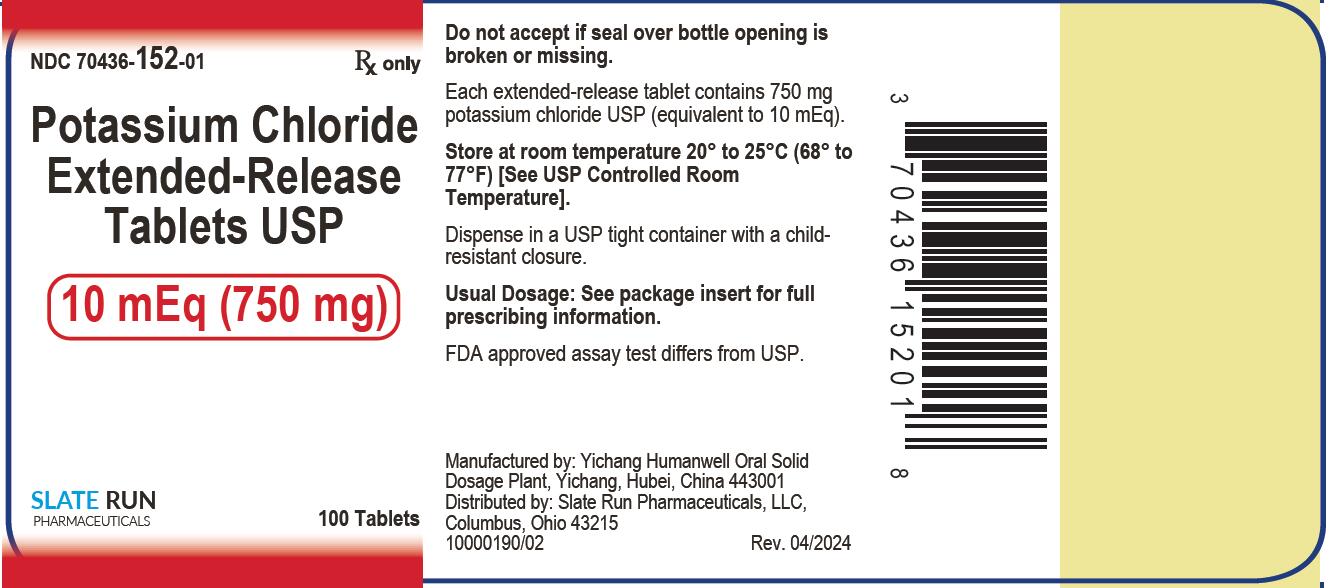
NDC 70436-152-03
Potassium Chloride Extended-release Tablets, USP
10 mEq (750 mg)
1,000 Tablets
Rx only

NDC 70436-153-01
Potassium Chloride Extended-release Tablets, USP
20 mEq (1500 mg)
100 Tablets
Rx only
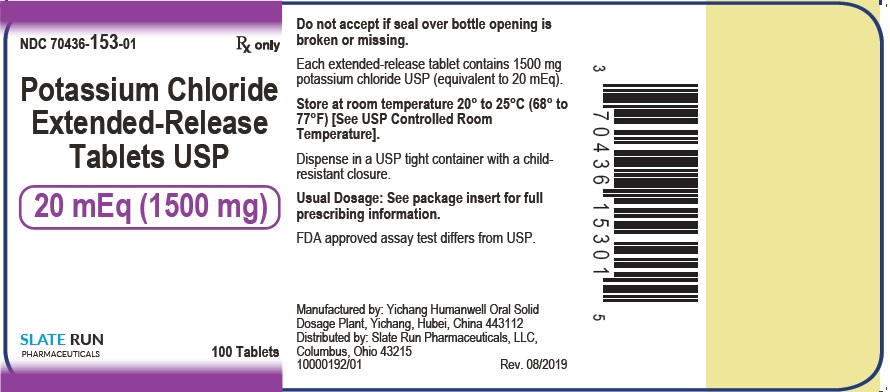
NDC 70436-153-02
Potassium Chloride Extended-release Tablets, USP
20 mEq (1500 mg)
500 Tablets
Rx only
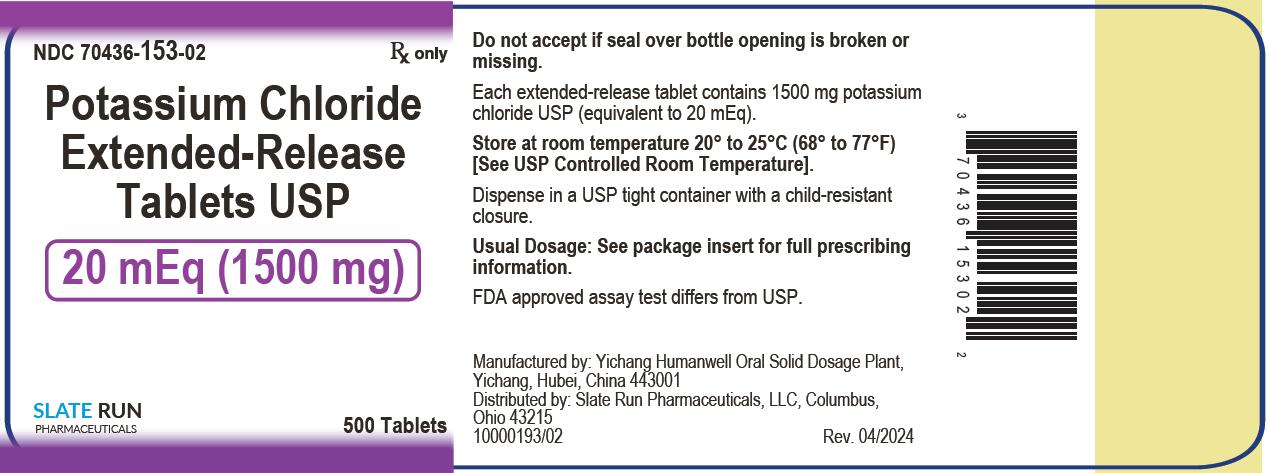
-
INGREDIENTS AND APPEARANCE
POTASSIUM CHLORIDE
potassium chloride tablet, film coated, extended releaseProduct Information Product Type HUMAN PRESCRIPTION DRUG Item Code (Source) NDC:70436-153 Route of Administration ORAL Active Ingredient/Active Moiety Ingredient Name Basis of Strength Strength POTASSIUM CHLORIDE (UNII: 660YQ98I10) (POTASSIUM CATION - UNII:295O53K152) POTASSIUM CHLORIDE 1500 mg Inactive Ingredients Ingredient Name Strength SILICON DIOXIDE (UNII: ETJ7Z6XBU4) HYPROMELLOSE 2910 (6 MPA.S) (UNII: 0WZ8WG20P6) TALC (UNII: 7SEV7J4R1U) POLYVINYL ACETATE (UNII: 32K497ZK2U) POVIDONE K30 (UNII: U725QWY32X) SODIUM LAURYL SULFATE (UNII: 368GB5141J) TRIETHYL CITRATE (UNII: 8Z96QXD6UM) HYDROGENATED COTTONSEED OIL (UNII: Z82Y2C65EA) MICROCRYSTALLINE CELLULOSE (UNII: OP1R32D61U) Product Characteristics Color white (White to off-white) Score no score Shape OVAL (Biconvex) Size 20mm Flavor Imprint Code YH155 Contains Packaging # Item Code Package Description Marketing Start Date Marketing End Date 1 NDC:70436-153-01 100 in 1 BOTTLE; Type 0: Not a Combination Product 02/01/2020 2 NDC:70436-153-02 500 in 1 BOTTLE; Type 0: Not a Combination Product 02/01/2020 Marketing Information Marketing Category Application Number or Monograph Citation Marketing Start Date Marketing End Date ANDA ANDA212561 02/01/2020 POTASSIUM CHLORIDE
potassium chloride tablet, film coated, extended releaseProduct Information Product Type HUMAN PRESCRIPTION DRUG Item Code (Source) NDC:70436-152 Route of Administration ORAL Active Ingredient/Active Moiety Ingredient Name Basis of Strength Strength POTASSIUM CHLORIDE (UNII: 660YQ98I10) (POTASSIUM CATION - UNII:295O53K152) POTASSIUM CHLORIDE 750 mg Inactive Ingredients Ingredient Name Strength POLYVINYL ACETATE (UNII: 32K497ZK2U) POVIDONE K30 (UNII: U725QWY32X) SODIUM LAURYL SULFATE (UNII: 368GB5141J) TRIETHYL CITRATE (UNII: 8Z96QXD6UM) HYDROGENATED COTTONSEED OIL (UNII: Z82Y2C65EA) MICROCRYSTALLINE CELLULOSE (UNII: OP1R32D61U) SILICON DIOXIDE (UNII: ETJ7Z6XBU4) POLYVINYL ALCOHOL GRAFT POLYETHYLENE GLYCOL COPOLYMER (3:1; 45000 MW) (UNII: 23ZQ42JZZH) TALC (UNII: 7SEV7J4R1U) TITANIUM DIOXIDE (UNII: 15FIX9V2JP) FERROSOFERRIC OXIDE (UNII: XM0M87F357) GLYCERYL CAPRYLOCAPRATE (UNII: U72Q2I8C85) POLYVINYL ALCOHOL (UNII: 532B59J990) FERRIC OXIDE YELLOW (UNII: EX438O2MRT) Product Characteristics Color yellow Score no score Shape OVAL (Biconvex) Size 15mm Flavor Imprint Code YH156 Contains Packaging # Item Code Package Description Marketing Start Date Marketing End Date 1 NDC:70436-152-01 100 in 1 BOTTLE; Type 0: Not a Combination Product 02/01/2020 2 NDC:70436-152-03 1000 in 1 BOTTLE; Type 0: Not a Combination Product 02/01/2020 Marketing Information Marketing Category Application Number or Monograph Citation Marketing Start Date Marketing End Date ANDA ANDA212561 02/01/2020 Labeler - Slate Run Pharmaceuticals, LLC (039452765) Registrant - Yichang Humanwell Pharmaceutical Co,. Ltd. (527225336) Establishment Name Address ID/FEI Business Operations Yichang Humanwell Oral Solid Dosge Plant 421371958 manufacture(70436-152, 70436-153)

